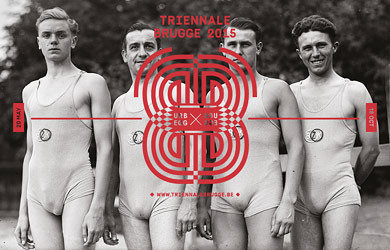Romy Achituv
Atelier Bow-Wow
Nathan Coley
Daniël Dewaele
Song Dong
Rainer Ganahl
Nicolas Grenier
HeHe
Vibeke Jensen
Tadashi Kawamata
Odland & Auinger
Anne K. Senstad
Studio Mumbai
Vermeir & Heiremans
19/5/2015
Bruges Contemporary Art 2015
Different Venues, Brugge
And Architecture Triennial. The project takes a proposition as a starting point: What if we were to inject Bruges with the essence of a megapolis? The question becomes a thought experiment, a driver for an artistic investigation into urbanisation and identity.

Contemporary art in a historic city. It is not a contradiction. Centuries ago, Bruges was a breeding ground for visual artists. Van Eyck and his colleagues, first and foremost, but art was also prominent in later centuries. Today, Bruges is showcasing contemporary art and architecture with a triennial, for the first time since 1974.
The triennial’s theme is worldwide, global urbanisation. 2007 was a pivotal moment in the history of man, because since then over 60 percent of the world population has lived in “megacities” or cities with over ten million inhabitants. In contrast Bruges appears relatively insignificant with its 117,000 inhabitants, 22,000 of which live in the historic city centre. Every year, Bruges welcomes 5.3 million tourists. Thus the idea of Bruges as a megacity is not so far fetched. What would happen if its five million visitors suddenly decided to make the city their home?
What if such a contemporary megacity were to invade this medieval, protected policy, this outdoor museum? Not literally, but with its metropolitan imagination, its artists, its urbanists, its critical, creative energy and all its questions related to urban architecture today. In short: with a triennial that turns the Venice of the North historically upside down and inside out.
Two narratives
The triennial contrasts two opposing narratives: the static image of Bruges as a protected medieval city that was restored and preserved from the 19th century onwards and a hypothetical 21st-century megapolis version of the city. The Triennial takes a proposition as a starting point: What if we were to inject Bruges with the essence of a megapolis? The question becomes a thought experiment, a driver for an artistic investigation into urbanisation and identity. What sort of opportunities and issues would arise from a change of this magnitude? And conversely, how might a small city like Bruges contribute to a new form of urbanism?
Art trail and three indoor exhibitions
This is the challenging city break on which the triennial has invited 18 international artists. Selecting a location was the first step in their creative process. Do they engage in dialogue with or in opposition to a particular site? Does it become a catalyst or a volatile obstacle? And how do they sneak into the metropolis? In the form of a thought, a picture or a shock-provoking element?
And how do they view Bruges? As a real city? Or as a historical, almost imaginary reflection of a city that never actually existed? A mirror naturally fraught with cracks and fissures. Because ultimately it is only a representation that incites artists to reflect on what is urban.
Other artists prefer to go in search of social connections, meeting places where work, the environment and visitors genuinely interact. Other current social themes, such as new citizenship, the invisible financial and economic dimensions, the real estate crisis, the city as a spectacle etc. are all explicitly or less explicitly explored.
And naturally there is the constant tension between the real Bruges, the historic Bruges that we imagine or proffer, and all the images of metropolises that in these times, we almost collectively share and inhabit, even if we have never visited them.
In addition to this art route there are also three indoor exhibitions that delve deeper into the story of the city that challenges itself.
The indoor exhibition in the Arentshuis displays the visionary urban plans by the Belgian modernist Huib Hoste, who would have created a totally different Bruges in the interwar period. His designs are displayed alongside the city morphologies by the German Post-Modernist Oswald Mathias Ungers.
The exhibition in De Bond highlights the endless history of the destruction and reconstruction of cities in the Middle and Far East.
Lastly, in the Stadhuis (City Hall) several artists reveal a glimpse of their imaginary city.
Part of a continuum
The Bruges Contemporary Art and Architecture Triennial is linked to both an earlier tradition of art triennials that took place in the 1960s and ’70s and to a more recent series of major cultural events in the city: Bruges 2002, European Capital of Culture, Corpus (2005) and Bruges Central (2010). This is the first edition of a new series of contemporary art triennials.
Participating artists
Art trail
Romy Achituv (Israel/US), Atelier Bow-Wow (Japan), Nathan Coley (UK), Daniël Dewaele (Belgium), Song Dong (China), Rainer Ganahl (Austria/US), Nicolas Grenier (Canada), HeHe (UK/Germany), Vibeke Jensen (Norway), Tadashi Kawamata (Japan), Odland & Auinger (O+A) (US/Austria), Anne K. Senstad (Norway), Studio Mumbai (India), Vermeir & Heiremans (Belgium)
Exhibitions
Town Hall: Imaginary Cities
Bodys Isek Kingelez (Democratic Republic of Congo), Liu Wei (China), Tracey Snelling (US), Luc Schuiten (Belgium)
De Bond: Unfinished Cities
Ziad Antar (Lebanon), Iraida Icaza (Panama), Lida Abdul (Afghanistan), Alireza Rasoulinejad (Iran), Ahmed Mater (Saudi Arabia), Sami Al Turki (Saudi Arabia), Michael Wolf (Germany), Xing Danwen (China), Yang Yongliang (China)
Arentshuis: Visionary Cities
Oswald Mathias Ungers (Germany) & Huib Hoste (Belgium): The Visionary City
Stanza (UK): The Intelligent City
Curators
Till-Holger Borchert, Director Bruges Museums
Michel Dewilde, fine arts curator, Cultuurcentrum Brugge (Bruges Culture Centre)
Organisation
Bruges Triennial 2015 is an initiative of the City of Bruges, organised by Brugge Plus in collaboration with Bruges Museums and Cultuurcentrum Brugge.
Press Contact:
Shaheda Ishaque
pers@triennalebrugge.be / T +32 (0) 479 902 834
20 May–18 October 2015
Bruges
Different Venues



